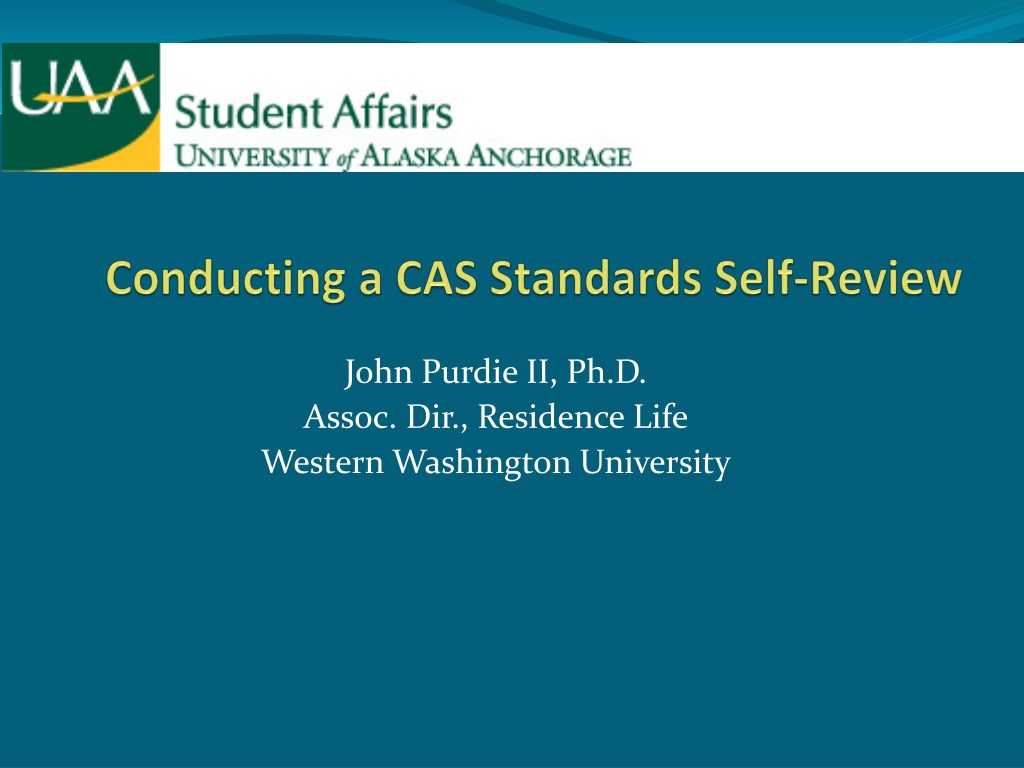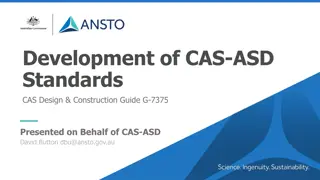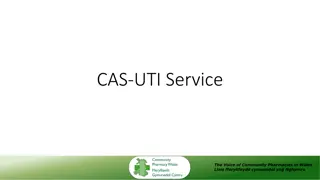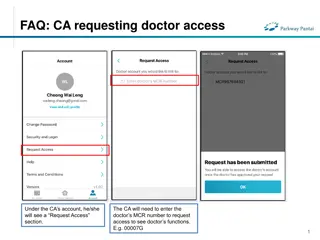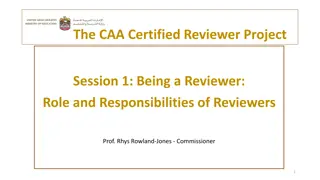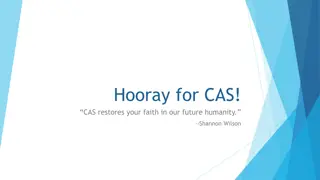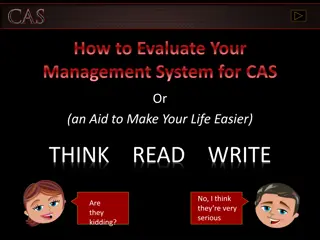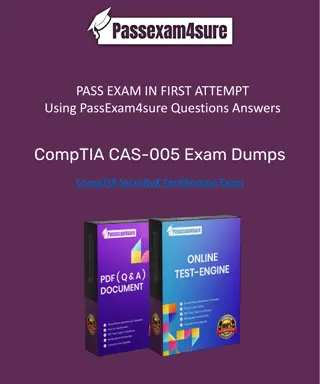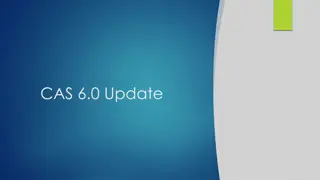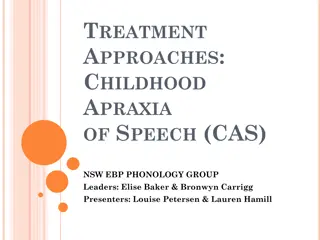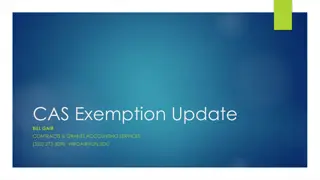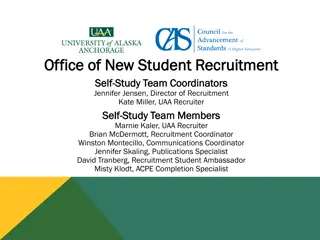Understanding CAS Standards in Higher Education
Explore the mission and purpose of the Council for the Advancement of Standards in Higher Education (CAS), which focuses on improving programs and services to enhance student learning and development. Learn about conducting CAS self-studies, participant outcomes, and the structured evaluation method provided by CAS.
Download Presentation

Please find below an Image/Link to download the presentation.
The content on the website is provided AS IS for your information and personal use only. It may not be sold, licensed, or shared on other websites without obtaining consent from the author. Download presentation by click this link. If you encounter any issues during the download, it is possible that the publisher has removed the file from their server.
E N D
Presentation Transcript
John Purdie II, Ph.D. Assoc. Dir., Residence Life Western Washington University
Remember getting a physical? Again this year, members of the Whatcom Medical Society will be performing sports physicals for Squalicum and other area high school athletes. This is not intended to be a comprehensive physical exam and should not take the place of those recommended by your family physician. These physicals are designed to be limited to sports- directed examinations. As such, only returning athletes (current 9th, 10th, and 11th graders) with record of a comprehensive exam on file at their high school will be eligible. INCOMING HIGH SCHOOL 9TH GRADERS ARE NOT ELIGIBLE.
What game are you playing? Together we provide an environment for our diverse student population to reach their greatest potential through inspiration, accessibility, and support. UAA Student Affairs departments and staff are committed to providing student-centered services and programs that support students' academic and social integration into the UAA community, engage students in active learning, and foster the growth and development of each student.
Purpose Introduce the CAS Standards Develop capacity to conduct a CAS self-study Provide support and motivation as you continue to progress toward becoming Able to demonstrate contributions to student learning
A Connoisseur, a Critic, and a Skeptic walk into a student union CAS provides a structured method of evaluation: Is the X functioning effectively to achieve its mission? X is usually a program , service, or department What evidence is available to support the determination?
Participant Outcomes In order to be able to conduct a CAS self-study, by the end of this session participants will be able to: Articulate the purpose and benefits of a self-study Feel increased self-efficacy Identify institutional stakeholders needed for the process Identify and obtain appropriate sources of data/evidence
What is CAS? The mission of the Council for the Advancement of Standards in Higher Education (CAS) is to promote the improvement of programs and services to enhance the quality of student learning and development. CAS is a consortium of 40 professional associations who work collaboratively to develop and promulgate standards and guidelines and to encourage self-assessment.
Hmmm... Essential Elements in the CAS Approach Culture that values involvement of all its members Has identified quality indicators Use of standards and guidelines Willingness/capacity: To examine itself and assemble results To report and use the results Has accountability, credibility, improvement Measures of quality & effectiveness, impact on learning, and program & service improvement
Evaluative Evidence STUDENTRECRUITMENT MATERIALS: Brochures & other program information Participation policies & procedures PROGRAM DOCUMENTS: Mission statements; program purpose & philosophy statements Catalogs & related materials Staff & student manuals; policies & procedures ADMINISTRATIVE DOCUMENTS: Organization charts; student & staff profiles Financial resource statements & budgets Annual reports
Evaluative Evidence (cont.) STAFF ACTIVITY REPORTS: Curriculum vitae & resumes; professional activity Service to other programs, departments, or community STUDENT ACTIVITY REPORTS: Portfolios, developmental transcripts, resumes Reports of student service RESEARCH & EVALUATION DATA: Needs assessments & self-studies Program evaluation; graduate & follow-up studies
Quantitative Data Summary of objective responses on a questionnaire or program evaluation Statistics about use by students and various population subgroups Needs assessments, follow-up studies, and self-study reports Institutional research reports and fact books Comparative or benchmark data at local, regional or national level
Qualitative Data Focus group information Written summaries of responses to open-ended questions in interviews and on evaluations Client satisfaction surveys, self-reports, and written comments, both solicited and unsolicited Team Discussion what would be useful and where can you get that
Organization of CAS Standards Mission Program Leadership Human Resources Ethics Legal Responsibilities Equity and Access Diversity Organization and Management Campus and External Relations Financial Resources Technology Facilities and Equipment Assessment and Evaluation
CAS: Standards and Guidelines STANDARD (BOLD TYPE; AUXILARY VERB MUST) Financial Aid Programs (FAP) must have adequate, suitably located facilities, adequate technology, and equipment to support its mission and goals efficiently and effectively. Facilities, technology, and equipment must be evaluated regularly and be in compliance with relevant federal, state, provincial, and local requirements to provide for access, health, safety, and security. GUIDELINE (LIGHT-FACED TYPE; VERB SHOULD) The program should have facilities or have access to: private office or space for confidential counseling, interviewing, and other meetings office, reception, and storage space and security sufficient to accommodate assigned staff, supplies, equipment, library resources, and machinery conference room or meeting space
"If you don't know where you are going, you will wind up somewhere else. ~Yogi Berra
CAS Self-Assessment Process Establish and prepare the Self-Assessment Team 1. 2. Compile and review Documentary and Evaluative Evidence 3. Identify Discrepancies 4. Determine appropriate Corrective Action 5. Recommend Steps for Program Enhancement 6. Prepare an Action Plan
The Self-Study Team Appointing the Team: Size of team 5 Composition: Faculty, Staff, Students & Others Most, if not all, should be from outside the unit At least 2 of those should be pretty knowledgeable Admin. support?
The Self-Study Team Training the Team: Establish team ground rules Discuss meaning of each standard Establish team s inter-rater reliability Encourage team discussion; expect disagreements; commit to consensual resolution
Participant Outcomes In order to be able to conduct a CAS self-study, by the end of this session participants will be able to: Articulate the purpose and benefits of the review Feel increased self-efficacy Identify institutional stakeholders needed for review process Identify and obtain appropriate sources of data/evidence With pilot teams after lunch: A cursory review of what and why In-depth on how (i.e., using SAGs)
